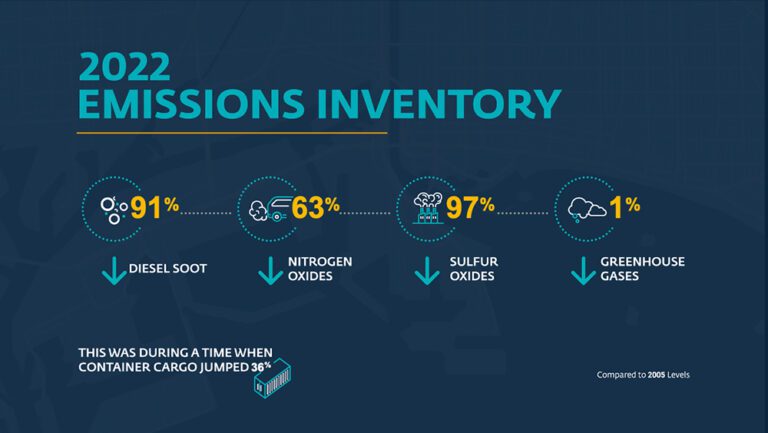Port Meets Clean Air Goals Ahead of Schedule

Record reductions in diesel particulate, nitrogen oxides
Air pollution emissions dropped significantly in 2022 at the Port of Long Beach in all categories, according to a new study that confirmed the Port had met all the goals of the San Pedro Bay Ports Clean Air Action Plan a year ahead of schedule.
The Port’s annual emissions inventory report, presented to the Long Beach Board of Harbor Commissioners on Monday, found that compared to 2005, diesel particulates are down 91%, nitrogen oxides have decreased 63%, and sulfur oxides have decreased 97%, all while cargo container volume increased 36%. Progress for the annual inventory is always compared against 2005, the year before the original San Pedro Bay Ports Clean Air Action Plan (CAAP) was adopted.
Several salient factors impacted activity, efficiency, operations and thus emissions in the 2022 study year. By mid-year, congestion related to the COVID-19 pandemic had subsided. Programs put into place to ease congestion, such as vessel queuing, reduced the number of ships waiting at anchor. The Port’s longstanding initiatives to make landside operations greener also continued to have an effect, with 19% of cargo-handling equipment at terminals now zero-emissions, as did the Port’s Clean Truck Program and the ongoing transition to cleaner trucks to move cargo.
“We’re proud of our green programs and commitment to sustainability,” said Long Beach Harbor Commission President Bobby Olvera Jr. “This emissions inventory is a feather in the Port’s cap, and we’re celebrating, but our sights are on the ultimate goals we’ve set, including zero-emissions cargo handling by 2030 and zero-emissions trucking by 2035.”
“The Port of Long Beach’s impressive record of environmental achievement is widely known,” said Port of Long Beach CEO Mario Cordero. “But we couldn’t accomplish all that we have without the close cooperation of our industry partners, labor and each part of the supply chain who does business with us. Everyone deserves a great deal of credit for their willingness to do the right thing for the planet, maintaining that commitment through some challenging recent years, and helping us reach these green milestones.”
Long an industry leader in environmentally sustainable seaport operations, the Port of Long Beach is driving to become the nation’s first zero-emissions port for drayage and cargo handling. Some notable strides toward these goals over the last year include:
- Recently, the Port recently announced a California State Transportation Agency grant of $225 million for the Port’s critical investments in equipment and infrastructure for zero-emissions goals. In total, the Port has successfully secured approximately $331 million in grant funding for zero- and near-zero emissions projects.
- The Port has also established the Zero Emissions, Energy Resilient Operations Program – known as ZEERO – to invest in projects aimed at reducing the impacts of operations and improving air quality. ZEERO includes a commitment to accelerate deployment of the lowest carbon emission alternatives for ocean-going vessels.
- Earlier this year, the Port unveiled plans to create Pier Wind, a facility that would support the manufacture and assembly of offshore wind turbines standing as tall as the Eiffel Tower. It would be the largest facility at any U.S. seaport specifically designed to accommodate the assembly of offshore wind turbines.
- In October 2022, the Port joined ARCHES – short for the Alliance for Renewable Clean Hydrogen Energy Systems. ARCHES is a public-private partnership formed to help capture newly available federal funding to assist in developing a robust renewable hydrogen market in California.
Learn more about the Port of Long Beach’s zero emissions program at www.polb.com/zeroemissions and the Port’s history of sustainability through the Green Port timeline.
This year’s inventory also represents significant improvement over the 2021 study, when the COVID-19 pandemic and global supply chain congestion resulted in higher emissions in San Pedro Bay. Compared to that year, in 2022 diesel particulate matter was down 28%, nitrogen oxides 28% and sulfur oxides 7%, even though container traffic dipped only 3%. Greenhouse gas emissions were down 1% in 2022 compared to the 2005 baseline, although the category was down 16% compared to the 2021 survey.
The annual emissions inventory is reviewed by the U.S. Environmental Protection Agency, California Air Resources Board and South Coast Air Quality Management District. Read about the Port’s emissions inventory here.
The Port of Long Beach is a global leader in green port initiatives and top-notch customer service, moving cargo with reliability, speed and efficiency. As the premier U.S. gateway for trans-Pacific trade, the Port handles trade valued at $200 billion annually and supports 2.6 million jobs across the United States, including 575,000 in Southern California. In 2022, industry leaders named it “The Best West Coast Seaport in North America” for the fourth consecutive year. During the next 10 years, the Port is planning $2.2 billion in capital improvements aimed at enhancing capacity, competitiveness and sustainability.


